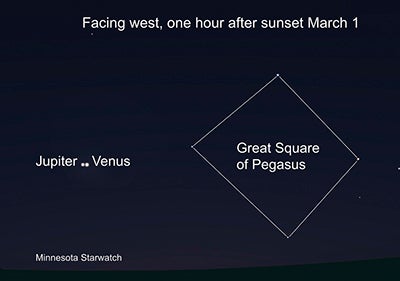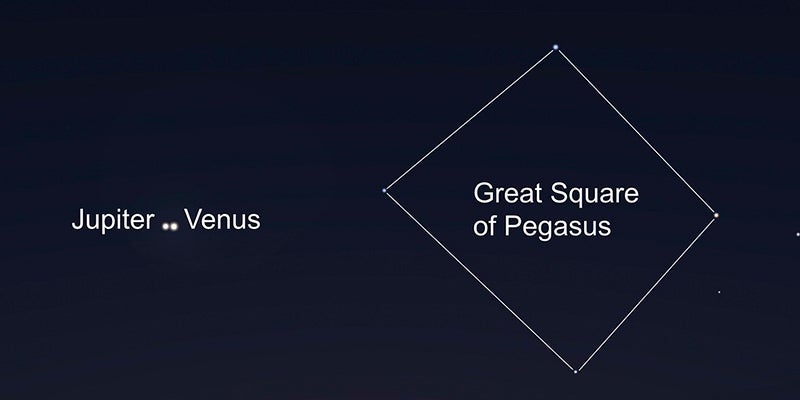Minnesota StarWatch: Neighbors in the sky
Published 5:25 pm Friday, February 24, 2023
|
Getting your Trinity Audio player ready...
|
By Deane Morrison
March always brings passages—winter to spring, ice to slush, sun to the Northern Hemisphere. This year, the month begins with an uncommon passage as the two brightest planets sweep by each other above the southwest horizon.
On Wednesday, the 1st, Jupiter passes within a moon width of brilliant Venus. The gap between them quickly widens as Jupiter falls into the sun’s afterglow. On Wednesday, the 22nd, a thin crescent moon appears above Jupiter about 40 minutes after sunset. The next night, the moon hangs below Venus.

Graphic provided
East of the planetary pair, Mars rides high at nightfall as the bright winter stars stream past it. In mid-month Mars glides between Betelgeuse, the giant red star at Orion’s right shoulder, and brilliant Capella, in Auriga, the charioteer. At month’s end the red planet will be heading into Gemini. Enjoy this feast of stars and Mars now, before the winter constellations also slip into the sunset.
March’s full moon arrives at 6:40 a.m. on Tuesday, the 7th, after crossing the night sky below the spring constellation Leo, the lion. The moon sets in the west shortly after reaching fullness, so plan accordingly.
Spring begins with the vernal equinox at 4:24 p.m. Monday, the 20th. At that moment the sun crosses the equator heading north, and Earth will be lighted from pole to pole. From then until the September equinox, the day length increases as we travel north. Also, the day length increases most rapidly near the spring equinox because the sun is then moving most rapidly northward.
If you’re out at the end of evening twilight between the 10th and the 22nd, look for a faint, broad cone of light extending up from the western horizon along the sun’s path. This is the elusive zodiacal light, the result of sunlight reflecting off dust in the plane of the solar system. Recent evidence has suggested a Martian origin for the dust.
For more information, see:
• Duluth, Marshall W. Alworth Planetarium: www.d.umn.edu/planet
• Twin Cities, Minnesota Institute for Astrophysics: www.astro.umn.edu/outreach/pubnight
• Check out astronomy programs, free telescope events, and planetarium shows at the University of Minnesota’s Bell Museum: www.bellmuseum.umn.edu/astronomy
Find U of M astronomers and links to the world of astronomy at: http://www.astro.umn.edu




